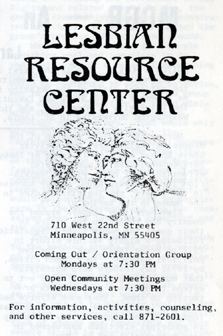Difference between revisions of "Lesbian Resource Center"
| (4 intermediate revisions by 3 users not shown) | |||
| Line 4: | Line 4: | ||
| + | {{unprotected}} | ||
{| {{prettytable}} | {| {{prettytable}} | ||
! | ! | ||
| Line 29: | Line 30: | ||
| − | The collectively-run organization—like others in the young GLBT community—was rife with infighting and | + | The collectively-run organization—like others in the young GLBT community—was rife with infighting and controversy. It appealed to a radical and politically active group of (predominantly young) lesbian women; some found the community center “a very depressing place, couches with springs coming out, it just had a terrible feeling…”<small>(5)</small> These negative qualities only dampened the organization slightly. Overwhelmingly, it was a place where many lesbian women discovered their identities and made lasting friendships. |
| + | ---- | ||
| + | ==This entry is part of:== | ||
| + | == [[Minneapolis/St. Paul, MN: 100 Queer Places in Minnesota History, (1860-2010)]]== | ||
---- | ---- | ||
| Line 44: | Line 48: | ||
<small>(5)</small> Enke, Anne. ''Finding the Movement: Sexuality, Contested Space, and Feminist Activism.'' North Carolina: Duke University Press, 2007. Page 226. | <small>(5)</small> Enke, Anne. ''Finding the Movement: Sexuality, Contested Space, and Feminist Activism.'' North Carolina: Duke University Press, 2007. Page 226. | ||
| − | |||
| − | |||
Latest revision as of 02:00, 20 January 2012
710 West 22nd Street, Minneapolis, MN
| An advertisement for the LRC in the 1974 Twin Cities Pride Guide. Courtesy of the Jean-Nickolaus Tretter Collection. |
“Gay Woman in the Minneapolis/St. Paul area have opened a Lesbian Resource Center in Minneapolis to better serve the needs of lesbians. We have found that other organizations are either too male or straight-oriented, leaving us with a sense of invisibility. We are now coming out completely, affirming we are here…”(1)
|
The LRC was a catalyst of pioneering organizations in Minneapolis; a collection of books from the Brown House commune became Amazon Feminist/True Colors Bookstore at this site, and the Lavender Cellar Theater, a lesbian theater group that formed before At the Foot of the Mountain Theater Company, used the space for their first performances in 1973.(4) A Woman's Coffeehouse also used the space before relocating to the Plymouth Congregational Church.
The collectively-run organization—like others in the young GLBT community—was rife with infighting and controversy. It appealed to a radical and politically active group of (predominantly young) lesbian women; some found the community center “a very depressing place, couches with springs coming out, it just had a terrible feeling…”(5) These negative qualities only dampened the organization slightly. Overwhelmingly, it was a place where many lesbian women discovered their identities and made lasting friendships.
This entry is part of:
Minneapolis/St. Paul, MN: 100 Queer Places in Minnesota History, (1860-2010)
(1)Grimstad, Kirsten and Rennie, Susan. The New Woman's Survival Catalog. New York: Coward, McCann & Geoghegan, 1973. Page 208.
(2)Wolfe, Maxine. "Community Centers" From Lesbian Histories and Cultures: An Encyclopedia. edited by Bonnie Zimmerman. New york: Taylor & Francis, 2000. Page 193.
(3)Tretter, Jean-Nickolaus. "The existence of a Gay Ghetto in Minneapolis." St. Paul, MN: Undergraduate paper submitted to the University of Minnesota’s Geography Department, 1976.
(4) Chinoy, Helen Krich. Women in American Theatre. New York: Theater Communications Group, 2007. Page 288.
(5) Enke, Anne. Finding the Movement: Sexuality, Contested Space, and Feminist Activism. North Carolina: Duke University Press, 2007. Page 226.
